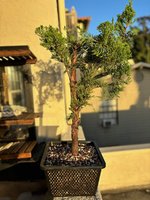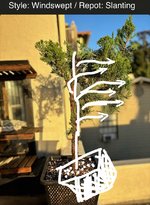zeejet
Mame
I recently chopped a rather tall 7' hollywood juniper (torulosa) from nursery stock and repotted it to a pond basket (partial - no bare rooting or serious root pruning).
I’m not sure how to approach this as this is also my first conifer. I’m thinking I should jin the chop site to create a cleaner transition and taper while wiring out the branches that are still flexible. I'm also not sure which branches to keep (I left a lot of foliage on for it to recover from the chop and repot). Also, if this thing has zero potential, I'd like top know as well so I'm not wasting my time.
Any advice would be appreciated.


I’m not sure how to approach this as this is also my first conifer. I’m thinking I should jin the chop site to create a cleaner transition and taper while wiring out the branches that are still flexible. I'm also not sure which branches to keep (I left a lot of foliage on for it to recover from the chop and repot). Also, if this thing has zero potential, I'd like top know as well so I'm not wasting my time.
Any advice would be appreciated.



